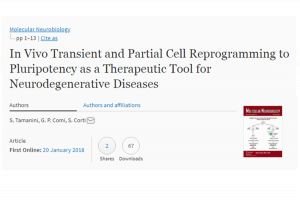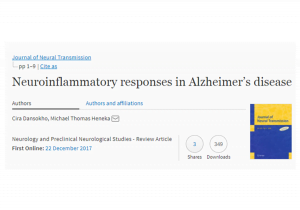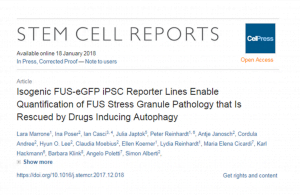 "Long-lasting pathological consequences of overexpression-induced α-synuclein spreading in the rat brain" has been published in Aging Cell. This work was supported in part by JPND through the GBA-PARK project, selected in the 2015 JPco-fuND call.
"Long-lasting pathological consequences of overexpression-induced α-synuclein spreading in the rat brain" has been published in Aging Cell. This work was supported in part by JPND through the GBA-PARK project, selected in the 2015 JPco-fuND call.
Yearly Archives: 2018
 "Impaired DNA damage response signaling by FUS-NLS mutations leads to neurodegeneration and FUS aggregate formation" has been published in Nature Communications. This work was supported in part by JPND through the TransNeuro and localMND projects, selected in the 2017 Pathways call.
"Impaired DNA damage response signaling by FUS-NLS mutations leads to neurodegeneration and FUS aggregate formation" has been published in Nature Communications. This work was supported in part by JPND through the TransNeuro and localMND projects, selected in the 2017 Pathways call.
More than 5 million Americans today are affected by Alzheimer's disease (AD). It is estimated that there will be more than 16 million people with AD in the United States and more than 60 million people with AD worldwide by 2050. In the past 25 years, only five symptomatic medications for AD have met their primary clinical endpoints in Phase III clinical trials and successfully come to market; of these, four are still available.
There is increasing evidence that multiple medical conditions increase the risk of neurodegeneration and subsequent development of dementia. It also is becoming clear that a majority of those risk factors acts in amyloid- and tau-independent ways. Since 2003, every symptom- and disease-modifying agent has failed in Phase II or III trials because of challenges with safety or efficacy, including trials testing the amyloid hypothesis, anti-inflammatory agents, and early-phase anti-tau therapies.
With disease-modifying treatment trials unsuccessful at the present time and only medications to treat symptoms available, what now?
Thinking "out-of-the-box," a scientist has developed an innovative program called the "Dementia Prevention Initiative" (DPI), which abandons generalized methods used to research and treat AD. The program has a novel "N-of-1 design" that individualizes medicine down to a single patient. Instead of conducting a conventional trial of 100 people all getting the same treatment, the scientist is conducting 100 single trials personalized to the individual. The youngest patient enrolled is 61 and the oldest is 86.
The DPI is a two-year clinical trial aimed at developing a best-practice model of personalized care that looks at each individual as the sole unit of observation. The idea is to treat neurodegenerative diseases as a disorder that develops over a lifetime and individualize ways to build a better brain as we age. The ultimate goal is to prevent dementia from happening in the first place.
The approach follows a form of personalized treatment similarly used in cancer and delivers an individualized prevention plan, tailored to each patient's risk profile based on their genetic traits, biomarkers (blood, imaging, and electrophysiology), socio-demographics, lifestyle choices, and co-existent medical conditions. This approach specifically targets the heterogeneity of AD by identifying person-specific risk factors and applying a customized intervention directed against this risk profile. The head scientist anticipates that this method will provide more rapid information on whether personalized prevention plans can improve person-centered outcomes.
Although the single greatest risk factor for AD is age, AD is not inevitable. It is estimated that at age 85 there is a 42 percent risk of developing AD, which means that 58 percent of older adults do not develop dementia, even if amyloid can be detected in the brain. The reasons are unknown, but may be explained in part by a host of modifiable and non-modifiable risk factors. Up to 30 percent of AD cases may be preventable through modification of risk factors and behavioral changes to mitigate the effect of those risk factors that can't be modified.
Nationally, if the onset of AD and related disorders is delayed by five years, 25 years later there would be approximately 5.7 million fewer cases, collective family savings would approach $87 billion, and societal savings would approach $367 billion.
Paper: “Prevention of Alzheimer's Disease: Lessons Learned and Applied”
Reprinted from materials provided by Florida Atlantic University.
 "Engaging older people in an internet platform for cardiovascular risk self-management: a qualitative study among Dutch HATICE participants" has been published in BMJ Open. This work was supported in part by JPND through the MIND-AD project, selected in the 2013 preventive strategies call.
"Engaging older people in an internet platform for cardiovascular risk self-management: a qualitative study among Dutch HATICE participants" has been published in BMJ Open. This work was supported in part by JPND through the MIND-AD project, selected in the 2013 preventive strategies call.
A new study shows that the taking of diabetes medicine reduces the risk of getting Parkinson´s disease.
Researchers have discovered that medical treatment against diabetes reduces the risk of getting Parkinson´s disease by 35 percent.
The researchers believe that diabetes medicines, containing glitazones, are influencing the cells to produce more mitochondria. Mitochondria are the powerhouse of the cells, transforming nutrients that the cells need to work.
The research group has previously shown that the production of mitochondria decreases during Parkinson´s.
To see the connection between diabetes and Parkinson´s, the researchers analysed and compared data from the Norwegian Prescription Data Base. The database has stored information on all use of prescription the last 10 years and contains data on more than 100 million prescriptions.
Paper: “Glitazone use associated with reduced risk of Parkinson's disease”
Reprinted from materials provided by University of Bergen.
 "In Vivo Transient and Partial Cell Reprogramming to Pluripotency as a Therapeutic Tool for Neurodegenerative Diseases" has been published in Molecular Neurobiology. This work was supported in part by JPND through the DAMNDPATHS project, selected in the 2013 cross-disease analysis call.
"In Vivo Transient and Partial Cell Reprogramming to Pluripotency as a Therapeutic Tool for Neurodegenerative Diseases" has been published in Molecular Neurobiology. This work was supported in part by JPND through the DAMNDPATHS project, selected in the 2013 cross-disease analysis call.
Increased communication between distant brain regions helps older adults compensate for the negative aspects of aging, reports a new study published this week in Human Brain Mapping.
The aged brain tends to show more bilateral communication than the young brain. While this finding has been observed many times, it has not been clear whether this phenomena is helpful or harmful and no study has directly manipulated this effect, until now.
The researchers used a brain stimulation technique known as transcranial magnetic stimulation (TMS) to modulate the brain activity of healthy older adults while they performed a memory task. When researchers applied TMS at a frequency that depressed activity in one memory region in the left hemisphere, communication increased with the same region in the right hemisphere, suggesting the right hemisphere was compensating to help with the task.
In contrast, when the same prefrontal site was excited, communication was increased only in the local network of regions in the left hemisphere. This suggested that communication between the hemispheres is a deliberate process that occurs on an "as needed" basis.
Furthermore, when the authors examined the white matter pathways between these bilateral regions, participants with stronger white matter fibers connecting left and right hemispheres demonstrated greater bilateral communication, strong evidence that structural neuroplasticity keeps the brain working efficiently in later life.
These results suggest that greater bilaterality in the prefrontal cortex might be the result of the aging brain adapting to the damage endured over the lifespan, in an effort to maintain normal function. Future brain-stimulation techniques could target this bilateral effect in effort to promote communication between the hemispheres and, hopefully, engender healthy cognition throughout the lifespan.
Paper: “Frequency-specific neuromodulation of local and distant connectivity in aging and episodic memory function”
Reprinted from materials provided by Duke University School of Medicine.
 "Neuroinflammatory responses in Alzheimer’s disease" has been published in the Journal of Neural Transmission. This work was supported in part by JPND through the MADGIC project, selected under the 2015 JPco-fuND call.
"Neuroinflammatory responses in Alzheimer’s disease" has been published in the Journal of Neural Transmission. This work was supported in part by JPND through the MADGIC project, selected under the 2015 JPco-fuND call.
The brain's own mechanisms for dealing with the loss of dopamine neurons in Parkinson's disease may be a source of the disorder's abnormal movement, according to a study published in Neuron.
The study suggests the loss of dopamine may cause the brain to rewire in a maladaptive manner, contributing to impaired movement in Parkinson's disease. These findings also suggest that there are fundamental problems with scientists' traditional model of Parkinson's disease, according to the researchers.
The prevailing consensus was that excessive patterning of the subthalamic nucleus (STN), a component of the basal ganglia, by the cerebral cortex was linked to the symptomatic expression of Parkinson's disease, including muscle rigidity and slowness of movement.
Thus, the researchers expected to see transmission in the cortex-to-STN pathway increase as dopamine levels dropped. Instead, they found the opposite: the strength of the pathway decreased massively.
Further investigation suggested abnormal activity in a more indirect pathway from the cortex to the STN, involving the globus pallidus, was responsible. Abnormal activity in the indirect pathway leaves the STN vulnerable to excessive excitation, triggering compensatory plasticity that ultimately proved to be harmful, according to the study.
When the scientists prevented this maladaptive plasticity in late-stage Parkinson's models, they found the symptoms improved, pointing to a link between compensation and motor dysfunction.
While the compensatory mechanisms may initially keep the brain operating normally under conditions of moderate dopamine neuron loss, as the disease progresses and more dopamine neurons die, the adaptations may become so extreme that they impair movement, according to the study.
These results suggest that there are fundamental flaws in our traditional understanding of brain dysfunction in Parkinson's disease.
Paper: “Loss of Hyperdirect Pathway Cortico-Subthalamic Inputs Following Degeneration of Midbrain Dopamine Neurons”
Reprinted from materials provided by Northwestern University.
 "Isogenic FUS-eGFP iPSC Reporter Lines Enable Quantification of FUS Stress Granule Pathology that Is Rescued by Drugs Inducing Autophagy" has been published in Stem Cell Reports. This work was supported in part by JPND through the CureALS project, selected in the 2015 JPco-fuND call.
"Isogenic FUS-eGFP iPSC Reporter Lines Enable Quantification of FUS Stress Granule Pathology that Is Rescued by Drugs Inducing Autophagy" has been published in Stem Cell Reports. This work was supported in part by JPND through the CureALS project, selected in the 2015 JPco-fuND call.
